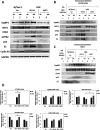A human papillomavirus 16 E2-TopBP1 dependent SIRT1-p300 acetylation switch regulates mitotic viral and human protein levels and activates the DNA damage response
- PMID: 38722185
- PMCID: PMC11237546
- DOI: 10.1128/mbio.00676-24
A human papillomavirus 16 E2-TopBP1 dependent SIRT1-p300 acetylation switch regulates mitotic viral and human protein levels and activates the DNA damage response
Abstract
An interaction between human papillomavirus 16 (HPV16) E2 and the cellular proteins TopBP1 and BRD4 is required for E2 plasmid segregation function. The E2-TopBP1 interaction promotes increased mitotic E2 protein levels in U2OS and N/Tert-1 cells, as well as in human foreskin keratinocytes immortalized by HPV16 (HFK + HPV16). SIRT1 deacetylation reduces E2 protein stability and here we demonstrate that increased E2 acetylation occurs during mitosis in a TopBP1 interacting-dependent manner, promoting E2 mitotic stabilization. p300 mediates E2 acetylation and acetylation is increased due to E2 switching off SIRT1 function during mitosis in a TopBP1 interacting-dependent manner, confirmed by increased p53 stability and acetylation on lysine 382, a known target for SIRT1 deacetylation. SIRT1 can complex with E2 in growing cells but is unable to do so during mitosis due to the E2-TopBP1 interaction; SIRT1 is also unable to complex with p53 in mitotic E2 wild-type cells but can complex with p53 outside of mitosis. E2 lysines 111 and 112 are highly conserved residues across all E2 proteins and we demonstrate that K111 hyper-acetylation occurs during mitosis, promoting E2 interaction with Topoisomerase 1 (Top1). We demonstrate that K112 ubiquitination promotes E2 proteasomal degradation during mitosis. E2-TopBP1 interaction promotes mitotic acetylation of CHK2, promoting phosphorylation and activation of the DNA damage response (DDR). The results present a new model in which the E2-TopBP1 complex inactivates SIRT1 during mitosis, and activates the DDR. This is a novel mechanism of HPV16 activation of the DDR, a requirement for the viral life cycle.
Importance: Human papillomaviruses (HPVs) are causative agents in around 5% of all human cancers. While there are prophylactic vaccines that will significantly alleviate HPV disease burden on future generations, there are currently no anti-viral strategies available for the treatment of HPV cancers. To generate such reagents, we must understand more about the HPV life cycle, and in particular about viral-host interactions. Here, we describe a novel mitotic complex generated by the HPV16 E2 protein interacting with the host protein TopBP1 that controls the function of the deacetylase SIRT1. The E2-TopBP1 interaction disrupts SIRT1 function during mitosis in order to enhance acetylation and stability of viral and host proteins. We also demonstrate that the E2-TopBP1 interaction activates the DDR. This novel complex is essential for the HPV16 life cycle and represents a novel anti-viral therapeutic target.
Keywords: E2; SIRT1; TopBP1; acetylation; cervical cancer; chromosome segregation; head and neck cancer; mitosis; p300; papillomavirus; switch.
Conflict of interest statement
The authors declare no conflict of interest.
Figures








Update of
-
A human papillomavirus 16 E2-TopBP1 dependent SIRT1-p300 acetylation switch regulates mitotic viral and human protein levels.bioRxiv [Preprint]. 2024 Jan 16:2024.01.15.575713. doi: 10.1101/2024.01.15.575713. bioRxiv. 2024. Update in: mBio. 2024 Jun 12;15(6):e0067624. doi: 10.1128/mbio.00676-24. PMID: 38293041 Free PMC article. Updated. Preprint.
References
MeSH terms
Substances
Grants and funding
LinkOut - more resources
Full Text Sources
Research Materials
Miscellaneous
